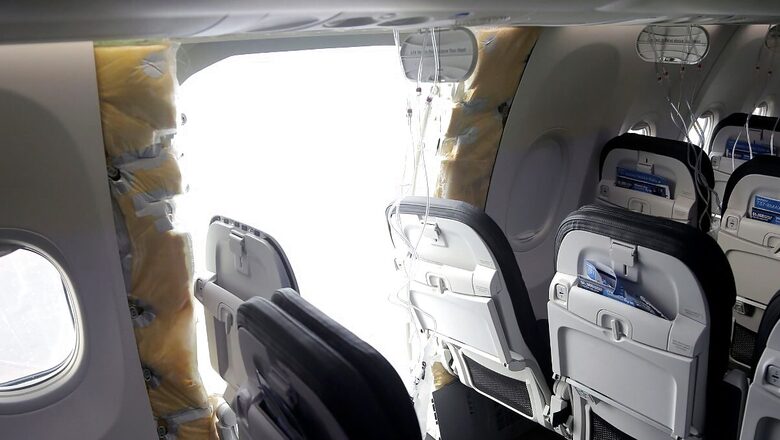
views
Investigators on Sunday said they have found the airplane door that blew off a Boeing airliner mid-flight over Oregon on Friday and hoped it would provide physical evidence of what went wrong.
Images posted on social media showed a gaping hole where the side panel had blown out, with emergency oxygen masks hanging from the ceiling.
The emergency, which saw no major injuries, prompted airlines and safety bodies around the world to ground some versions of the Boeing 737 MAX 9 jets pending inspections, with dozens of flights cancelled.
What Initial Investigation Suggest?
The gaping hole in the side of the Alaska Airlines jet opened up where aircraft maker Boeing fits a “plug” to cover an emergency exit that the airline does not use. The plugs are on most Boeing 737 Max 9 jets.
A door plug is a cover panel used to fill an unneeded emergency exit in planes with smaller seat configurations.
The Federal Aviation Administration has temporarily grounded those planes until they undergo inspections of the area around the door plug.
Officials with the National Transportation Safety Board, led by the board’s chair, Jennifer Homendy, arrived in Portland, Oregon, on Saturday to begin an investigation that is likely to last a year or longer. Homendy declined to discuss possible causes when she briefed reporters on Saturday night.
Immediate Inspections
The FAA said on X that it “is requiring immediate inspections of certain Boeing 737 MAX 9 planes before they can return to flight”.
It added that around 171 aircraft worldwide would be affected, with each inspection taking four to eight hours.
US-based Alaska and United Airlines fly the largest number of MAX 9 planes of any carrier and said on Sunday they had grounded their aircraft for inspection.
Other airlines with smaller MAX 9 fleets, including Turkish Airlines, said they did the same. Boeing has so far delivered about 218 of the 737 MAX planes worldwide, the company told AFP.
The plane manufacturer late Sunday said its chief executive Dave Calhoun has set an all-employee safety meeting for Tuesday at the company’s factory in Washington state, and cancelled a leadership summit.
Why The Plug is There?
Some larger Boeing 737s have emergency exits on fuselages behind the wings to meet a federal requirement that planes be designed so passengers can evacuate within 90 seconds even if half the exits are blocked.
The more passenger seats there are on a plane, the more exits are required.
Some carriers, including Indonesia’s Lion Air and Corendon Dutch Airlines, cram more than 200 seats into their Max 9s, so they must have extra emergency exits. However, Alaska Airlines and United Airlines configure their 737 Max 9s to have fewer than 180 seats, so the planes don’t need the two mid-cabin exits to comply with U.S. evacuation rules.
On Alaska and United, the only two US airlines using the Max 9, those side exits near the back of the plane are replaced with a permanent plug the size of an exit door.
Who Installs the Plugs?
A spokesman for Spirit AeroSystems, which is unrelated to Spirit Airlines, confirmed to The New York Times that the company installed door plugs on Max 9s, including the plug on the Alaska Airlines plane involved in Friday’s incident.
The spokesman told The Associated Press that the plugs are assembled into 737 fuselages at Spirit’s factory in Wichita, Kansas, but declined further comment.
The Boeing Supplier
Spirit is Boeing’s largest supplier for commercial planes and builds fuselages and other parts for Boeing Max jets. The company has been at the center of several recent problems with manufacturing quality on both the Max and a larger plane, the Boeing 787 Dreamliner. Last year, Boeing and Spirit AeroSystems discovered improperly drilled fastener holes in a bulkhead that keeps 737 Max jets pressurized at cruising altitude.
Were There Warnings?
The Boeing jetliner was not being used for flights to Hawaii after a warning light that could have indicated a pressurization problem lit up on three different flights, Homendy said Sunday.
Alaska Airlines decided to restrict the aircraft from long flights over water so that if the warning light reappeared, the plane “could return very quickly to an airport,” she said at a news conference.
Homendy cautioned that the pressurization light might be unrelated to Friday’s incident and more investigation was required.
Other Fuselage Blowouts
There have been rare instances of holes opening in the fuselages of airliners. In most cases, they have been the result of metal fatigue in the plane’s aluminum skin.
In the most horrific case, a flight attendant for Aloha Airlines was blown out of the cabin of a Boeing 737 over the Pacific Ocean in 1988 after an 18-foot-long (5.4-meter-long) chunk of the roof peeled away. Her body was never found. The tragedy led to tougher rules for airlines to inspect and repair microscopic fuselage cracks before they tear open in flight.
In 2009, a hole opened in the roof of a Southwest Boeing 737 flying 35,000 feet over West Virginia. And in 2011, a 5-foot (1.5-meter) gash unfurled in another Southwest Boeing 737, forcing pilots to make an emergency landing at a military base in Arizona. No one was injured in either of those cases, both of which were blamed on metal fatigue.
(With inputs from Associated Press)

















Comments
0 comment